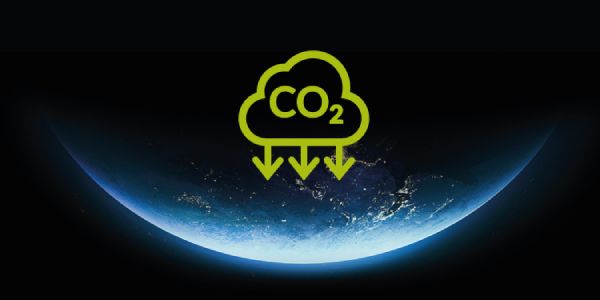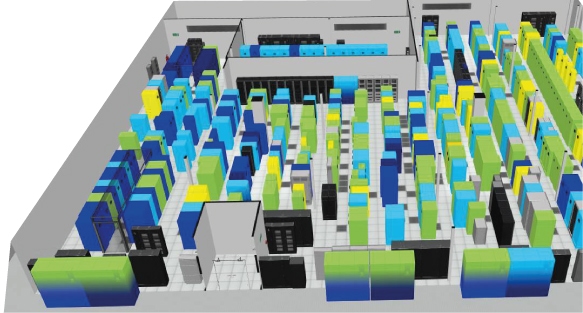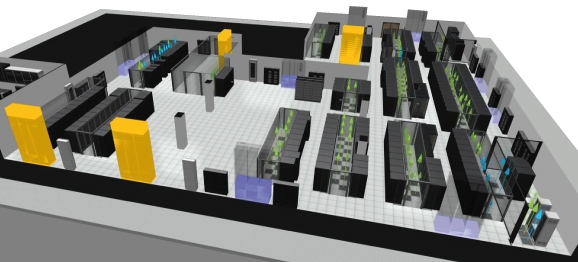Data center cost savings

Data Center energy waste could be costing you the Earth. A guide from EkkoSense on data center energy optimization and cutting your data center energy usage by a third.
At a time when organizations worldwide are committing to ambitious net zero carbon reduction targets, research from data center performance optimization specialist EkkoSense suggests that many operations are missing out on proven ways to reduce their cooling energy consumption.
Missing out on proven ways to cut data center cooling energy use.
EkkoSense’s research findings – based on rack-level analysis from a broad range of data center halls – suggests that…
The research assessed cooling performance across a sample of some 133 data center halls with granular analysis of over 33,000 IT racks.
The results showed that the current average data center cooling utilization level is only 40%. EkkoSense’s research also identified that those organizations that have implemented an effective thermal optimization programme have collectively secured a cumulative 10MW+ cooling power saving – equivalent to a minimum $10 million cooling energy data center cost saving since deployment. In carbon terms, this equates to a cumulative saving of around 20,000 tonnes CO2-eq emissions reduction through data center energy optimization.
EkkoSense’s latest research follows on from a study conducted by the company four years ago. Comparing the two sets of findings shows that it’s hard to identify any underlying improvements in efficiency across the data center sector during this period, with comparative findings showing:
- An increase in potential data center cooling energy savings up from 24% to 30%
- No improvements in data center cooling utilization levels across the industry
- Ongoing levels of significant risk in the whitespace, with a consistent 15% of racks remaining outside ASHRAE compliance
EkkoSense’s analysis of the actual cooling performance within live data centers – for many of the world’s leading brands – suggests that organizations are currently missing out on proven ways of cutting their data center cooling energy consumption by up to 30%.
When this level of performance optimization is applied to the broader global estate of 22,474 midsize, enterprise and larger hyperscale data centersii, EkkoSense believes that potential worldwide cooling energy savings of over $1.7 billion per year are fully realizable. Additionally, an overall annual carbon emissions reduction of some 3.3 million tonnes CO2-eq worldwide could be quickly secured simply by applying the systematic and synchronized application of data center cooling optimization best practices on a global basis.
The good news is that, with the latest generation of software-driven data center optimization solutions, there’s a real opportunity for organizations to achieve significant carbon reductions. From its research into the kind of optimization benefits that are attainable, EkkoSense analysis shows that data center operators can reduce their cooling energy consumption significantly. Indeed, EkkoSense’s in-depth analysis of data center thermal performance shows that it’s now possible to secure cooling energy consumption reductions of around a third simply by following current thermal optimization best practices.
That’s an action that few data center teams can afford to ignore – particularly as the pressure to deliver energy savings and meet carbon reduction targets intensifies.
Need to start delivering on ‘net zero’ carbon commitments.
Following the inauguration of Joe Biden as US President and the decision for the USA to rejoin the Paris climate accord, there’s a renewed focus on broader initiatives to address the climate crisis.
According to the United Nations Framework Convention on Climate Change, 2020 saw the number of commitments to reach net zero emissions from local governments and businesses roughly double in less than a year. At the same time, many investors are now asking companies to reveal their exposure to net zero commitments – with the focus not just on risk exposure but also how they are progressing towards achieving their targets.
Given that both the public and private sectors have been making dramatic net zero carbon commitments, there’s going to be increased pressure on organisations and the high energy users within them to start making serious carbon reductions. Stripping out significant data center cooling costs can make a huge difference, while at the same time helping organizations address their growing obligation not just to deliver quantifiable carbon reductions but also to be seen to be delivering against this agenda.
The scale of the challenge is huge, but the pace of transition is accelerating, and more and more companies are starting to take it very seriously. In fact, there are signs that many organisations are looking to go much further than initial ‘net zero by 2050’ targets, with some brands citing 2030 as their ambitious goal.
Data centers have a critical role to play in helping to deliver ‘net zero’.
Data centers have a critical role to play here in meeting these targets. With data centers already established as one of the world’s highest collective consumers of energy, it’s imperative that IT operations teams do everything they can to deliver the quick carbon reduction wins that will help organizations to deliver on their net zero commitments. And with around 35% of this energy taken up by powering cooling equipment, any initiative that can reduce data center cooling will help to make a significant contribution to carbon reduction.
Initiatives such as the Climate Neutral Data Centre Pact – a European self-regulatory initiative to help make data centers in Europe climate neutral by 2030 – demonstrate the strong commitment among cloud infrastructure and data center providers to lead the transition to a climate neutral economy. Similar initiatives include the ‘2020 Best Practice Guidelines for the EU Code of Conduct on Data Centre Energy Efficiency’ (co-authored by an EkkoSense non-executive director) that sets out best practices for data center operators and levels of expected minimum practices.
However, achieving these commitments and maintaining best practice standards could be a considerable challenge for the many data center or facilities teams that don’t yet have a clear understanding of how their data center rooms are performing from a thermal, capacity and power perspective. While data center operators can clearly deliver unprecedented efficiency and environmental performance levels at hyperscale, the reality is that many midsize and enterprise data centers still face considerable operational cooling and efficiency challenges.
Given that the typical response of many organizations facing IT cooling challenges is to further invest in more expensive cooling equipment, EkkoSense’s findings show that the underlying cause of poor data center thermal compliance is clearly not a lack of cooling capacity. Instead, facility teams and other technical stakeholders need to be focused on optimizing their data centers’ thermal performance and using their investment in existing cooling systems more efficiently. This not only results in data center cost savings year on year but also eliminates, or defers, the need for expensive cooling capital investment while also freeing up valuable data center capacity.
It’s clear that the global data center industry should be grabbing hold of the optimization opportunity with both hands. This is particularly the case given the $1.7 billion plus potential global data center cooling energy savings that are achievable simply by applying the systematic and synchronized application of data center cooling and optimization best practices. However, before unlocking these potential savings, data center operations need to look beyond their legacy DCIM (Data Center Infrastructure Management) reporting tools to start to uncover the tangible M&E insights that in turn will allow their data center estates to be run much leaner.
Data center cost savings. Optimizing data center performance with EkkoSense.
EkkoSense is a global leader in the provision of software-driven thermal optimization solutions for critical live environments.
With its powerful EkkoSoft Critical SaaS 3D visualization and analytics solution for data centers, EkkoSense is making it even easier for data center operations teams to collect granular real-time data, visualize airflow management improvements, manage complex capacity decisions, and quickly highlight any worrying trends in cooling performance.
The key difference with the EkkoSense approach is that the solutions not only pick up the problems or underlying negative trends but also suggest best practice solutions based on EkkoSoft Critical’s extensive knowledge base and deep analytics capability. This effectively removes data center thermal risks and provides 100% rack-level ASHRAE thermal compliance. All this comes at a fraction of the cost of more expensive and complex legacy data center DCIM or CFD solutions and offers a genuine ROI of less that 12 months in most cases.
EkkoSense has already helped its clients to reduce their cooling power-related carbon emissions by around 4,100 tonnes CO2-eq per year – equivalent to a cumulative 10 MW+ cooling power saving and a $10 million cooling energy data center cost saving. These totals are being added to on a daily basis.

Win/win performance optimization.
For data center operators this kind of performance optimization is a win/win proposition.
Cooling energy usage reducing by 30%, presents a clear carbon emissions saving that will support their net zero emissions programmes, while also delivering a net cut in their overall data center cooling energy spending as well as potentially eliminating additional capital investment.
EkkoSense’s distinctive software optimization approach allows data center operations teams to gather and visualize cooling, power and space data at a granular level. Customers can analyze multiple complex data sets simply and quickly in an easy-to-interpret 3D environment, and then apply AI and machine learning analytics techniques to secure actionable performance improvements. Once actioned, these processes can be repeated and measured for continuous 24×365 optimization.
This kind of approach goes beyond legacy DCIM reporting tools to provide tangible M&E insights that in turn allow data center estates to be run much leaner. Decisions can also be made more quickly, thanks to true live capacity planning functionality.
However, it’s also important to look for capabilities that make data center capacity planning and management even easier for operations teams to action. Transitioning from more static legacy DCIM approaches to true live capacity planning presents a great opportunity to take more control of data center estates – making the real-time operation and management of power, cooling and space a reality and helping data centers to run more efficiently.
Functionality here that can deliver real value includes the ability to reserve data center space, power and cooling for future projects, as well as introducing intuitive ticketing and change workflows to simplify activities for operations teams. Examples include making it much easier to add new racks, enable further capacity or reduce space from racks, and also remove existing racks entirely. These features make a huge difference for data center teams that are currently limited by complex DCIM systems that they find difficult to manage, or who are still relying on unwieldy spreadsheets to manage capacity changes to their estate.

- Based on UK Government GHG Conversion Factors for company reporting.
- Based on Garter Forecast Analysis: Data Center Sites Worldwide – 11 September 2020 –
- based on global numbers for midsize, enterprise and hyperscale data centers.

Anuraag Saxena
Data Center Optimization Manager, EkkoSense